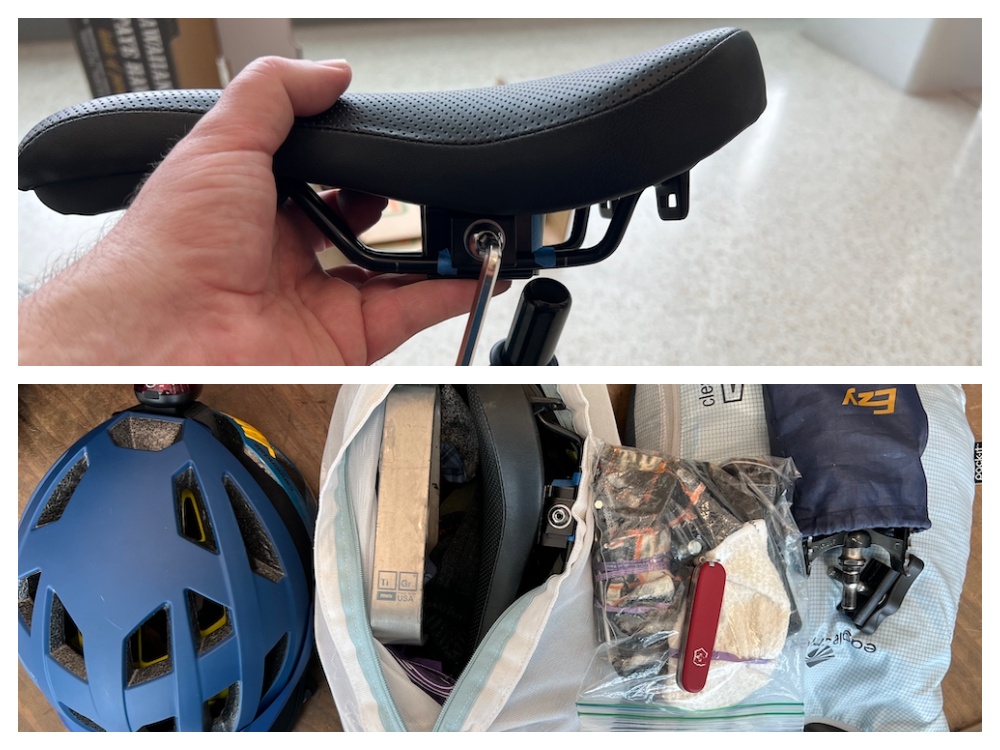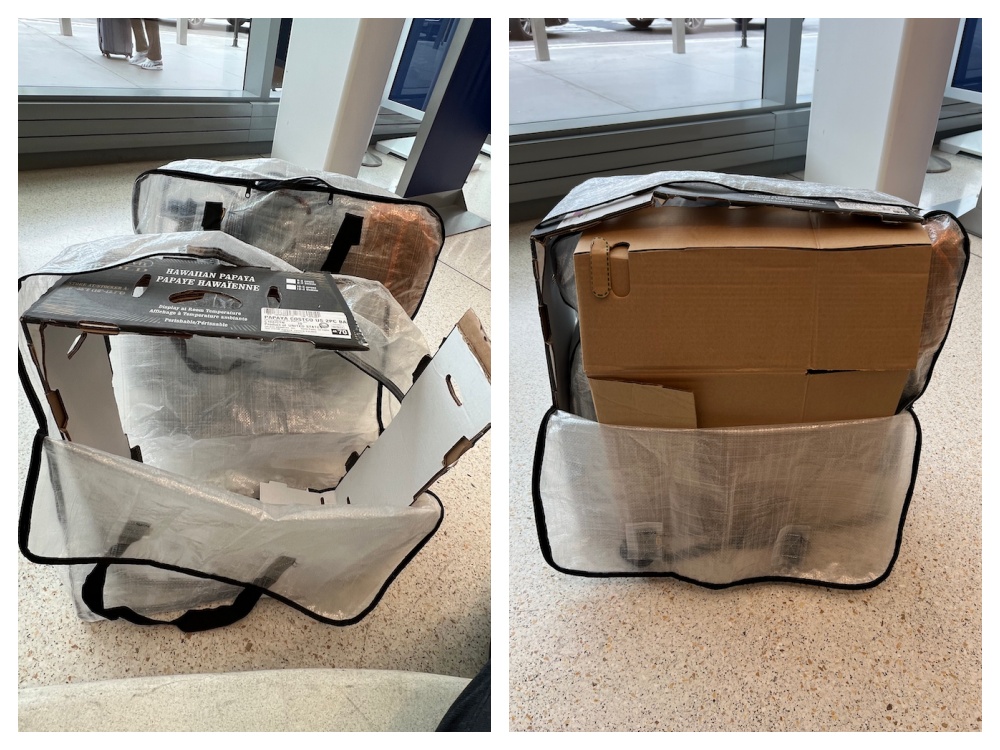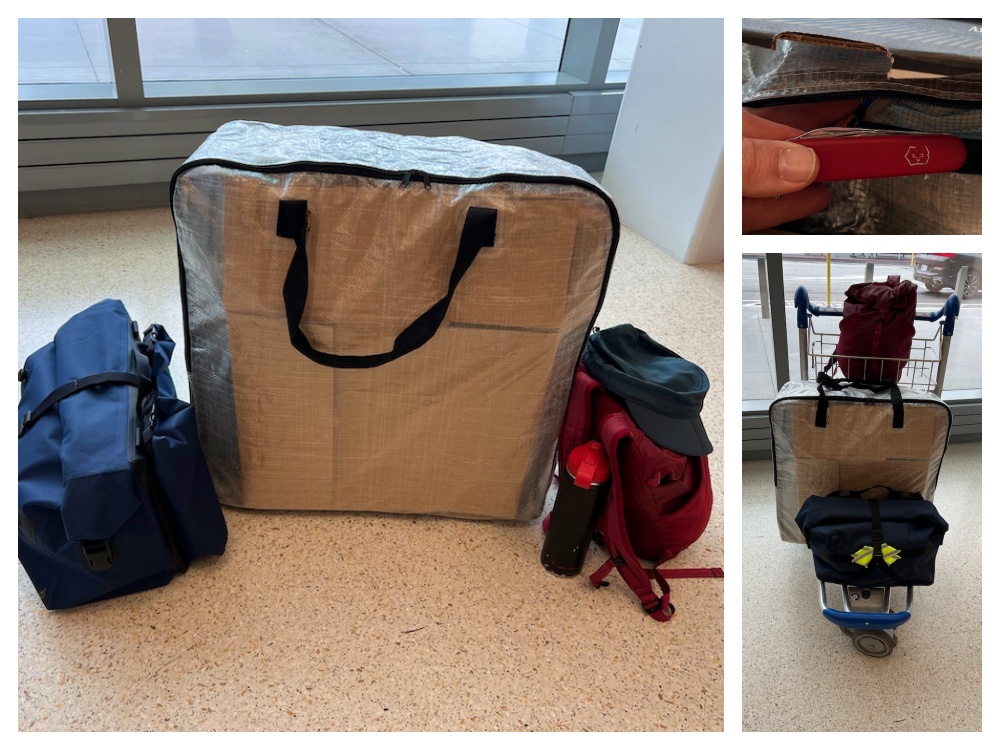Packing Brompton for Airline Baggage
After years of listening to friends rave about their Brompton folding bicycles, I finally bought one for a series of multimodal trips through different cities, both in the US and abroad. On my recent one-week California trip, I flew with the bike, checked as regular airline baggage, into San Diego, then combined different modes of transit up the coast to San Francisco. I pedaled along the Pacific Ocean for a few days, but also packed the bike in my family’s rental car, took it on my Amtrak train from LA to Oakland, on the city bus to my son’s neighborhood at night, more pedaling around the Bay Area, then eventually on the BART train to the San Francisco airport for my return trip home.
Since my California trip began in one location and ended in another, I searched for inexpensive ways to pack my Brompton for air travel, without using a hard-shell suitcase that could not be carried on the bike. My current solution came from Pam and Gilbert’s wonderful 2Bikes4Adventure Youtube video, which credits many other people who have embraced this popular method. The not-so-secret ingredient is to purchase two $7 IKEA Dimpa bags. Fold up the bike inside one bag, put it inside the second bag, then strategically place cardboard between the two bags as padding. A Dimpa bag measures 25.5 x 8.75 x 25.5 inches (65 x 65 x 22 cm) and does not exceed the standard 62 linear inch requirement for checked bags on most airlines. Also, the weight of a 27-pound Brompton plus some gear does not exceed the standard airline 50-pound baggage weight limit. Upon arrival, the strong-but-lightweight Dimpa bags fold up and fit neatly in the bottom of my large 25L Brompton front bag. At the end of my trip, I find new cardboard and cut it to size to repack the Brompton at the airport. To be clear, this dual-Dimpa-plus-cardboard method involves some risk of damage if your Brompton is dropped or crushed by other checked baggage. But so far, my experience tells me that the Brompton—especially with the optional rear rack installed for extra strength—is a tough little bike that likes to travel. Here’s more info about my current packing method:

Before packing the Brompton, I remove both folding clamps and both pedals. The Brompton’s folding clamps easily unscrew all the way. To simplify pedal removal, before my trip I took off the original Brompton pedals (the left-side folding pedal did not impress me) and replaced them with a $65 pair of black MKS quick-release (QR) touring pedals. The QR activates by rotating and releasing a spring-loaded connector about one-quarter turn. These pedals are fabulous, and once you get the feel for the QR, it’s smooth and simple, but practice a bit before your first trip. Both the pedals and the folding clamps fit neatly into a small bag that came with the pedals.

Next I remove the Brompton seat clamp, using a medium-length 5mm hex key I bring on my travels. While I could use the 5mm bit inside Brompton’s clever internal tool kit, I feel more confident that my longer hex key will offer more leverage if needed. All of these loose items, plus my TiGr bike lock, get stowed in a packing cube with my clothing, to cushion them when I pack them into the bike bag.

Now I place the folded Brompton into the first Dimpa bag. Since the seat post sticks up a few inches, I cover it with a jacket placed inside an upside-down bag. Then I place my packing cubes of clothing (with bike parts inside) to serve as padding on top. If you look closely at the photo you’ll also notice that I rubber-band a towel around the left crank arm in its vertical upwards position, to fill the gap between the crank arm and the bike. Not sure if this step is necessary, but I need to pack my camping towel somewhere so this seems like a good place. On the other side of the bike, the right crank arm is pointed down and seems more protected by the fold, so no coverage is necessary there.

Next I place the first Dimpa bag inside the second Dimpa bag, and strategically pack cardboard between them. The goal is to place lengthy 8-inch wide strips around the perimeter, plus two 24x24-inch cardboard squares on each side. Watch Pam and Gilbert’s 2Bikes4Adventure Youtube video with its animated graphics. Of course, you’ll need to acquire cardboard before you pack up your bike. The night before my return trip, my son gave me a medium-sized 12x16-inch box, which I folded down and bungee-corded onto the Brompton rear rack for my bike ride and transit trip to the airport. Also, when arriving at the airport, I had built in extra time before my flight (being a Dad, after all) so searched around for more cardboard. To my delight, I found an empty heavy-duty box that previously carried Hawaiian papaya fruit, which someone left outside near baggage claim. Always look for cardboard in places where other people are likely to have left it behind. Also, I bring a small jack knife on my bike travels, and it’s an essential tool to trim, score, and fold cardboard to add more protection to corners between the two bags.

Two final tips: First, after finishing the cardboard trimming, remember to pack your jack knife inside your checked bag, since you cannot carry it through airport security. Second, the dual-bagged package—including the 27-pound Brompton plus any clothing or gear you pack inside—weighs around 35-40 pounds, and it’s awkward to carry by the Dimpa straps, so snag a spare airport cart to wheel it over to the baggage check-in counter.

To be clear, this packing method is not foolproof. My folded Brompton seems fairly well-protected inside two IKEA bags with a thick cardboard liner, but sometimes stuff happens to checked baggage. After my first flight, I noticed the rear fender was slightly bent against the tire, so I loosened the rear rack assembly, straightened it by hand, and tightened up the rear rack. Fortunately I had the experience of personally installing the rear rack a few weeks before my trip, so that quick repair was familiar and simple for me. But your mileage may vary. For my second packing, I’ve added thicker cardboard.
Overall, I bought the Brompton for multimodal trips (bike + bus/train/plane), most of which begin in one location and end in another. Packing the bike inside a heavy specialized hardshell suitcase is not an option because those cannot easily be attached to the bike. Since the two Dimpa bags neatly fold down inside my large Brompton front bag, and I can find new cardboard whenever I repack, the ease of this method outweighs the risks and works well for me. Check out your options and decide what works best for you.
